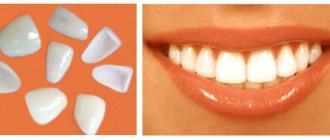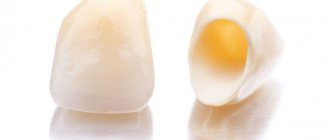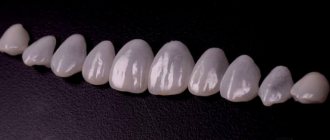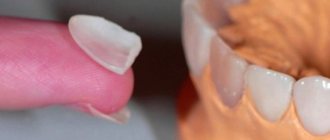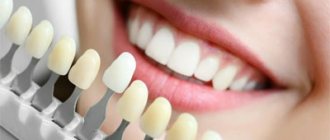Aesthetics and durability of finished products are features that distinguish pressed ceramic crowns. Over the past few years, IPS E-max press technology has firmly taken one of the leading positions in the field of domestic dental restoration, allowing the creation of high-quality prosthetic structures that are externally indistinguishable from exemplary natural teeth.
The technique, based on the principle of using all-frame structures, the material for which is potassium disilicate, demonstrates the effectiveness of using prostheses at a distance. The technology for processing blanks involves undergoing an injection molding procedure, which significantly increases the strength characteristics of the finished models. The use of special computer programs guarantees high precision of development, which allows you to create a variety of prosthetic systems - from classic single and extended replacement devices, to newfangled ultra-thin overlays for the front teeth - veneers.
Empress veneers review: key features, scope, reviews and prices
Article navigation
- Features and benefits of veneers
- Classification of materials
- How is it different from normal
- What is the difference between Empress and E.max veneer?
- Indications for installation
- When not to bet
- Manufacturing and installation stages
- Life time
- Recommendations
- Alternatives
- What is the price
- Questions and answers
Question for a specialist
Veneers in general are designed to hide visible defects and create a perfectly smooth and dazzling smile. Despite the common shape and indications, products from different brands differ in a number of characteristics - some are stronger, some look completely indistinguishable from natural teeth, and some have a very attractive price. Among them are Empress veneers, which have become the “gold standard” in the field of dental prosthetics using leucite glass ceramics.
Features of the technology
Empress inlays are manufactured using the injection (hot) pressing method using lost wax models. The process is divided into clinical and laboratory stages.
Clinical work is carried out by a dentist when working with a patient, laboratory work is carried out by a dental technician.
First visit to the clinic:
- Determination of indications and contraindications for Empress restoration.
- Anesthesia (if necessary).
- Cleansing teeth from soft plaque and stones.
- Color selection.
- Preparation - removal of caries, removal of tissue in height, grinding of sharp and thin edges. Upon completion, there should be no undercuts so that there are no problems with fitting and fixing the finished work.
- If necessary, the bottom of the cavity is “leveled” with a thin layer of composite material.
- Laying a retraction thread (the gingival edge moves away from the tooth and the border of the inlay is clearly visible). The exception is restoration within the chewing surface.
- Taking impressions. To obtain a highly accurate result, silicone or polyester masses are used (2 materials included). Alginate masses can be used to make impressions of antagonist teeth (opposite jaw).
- Removing the threads and closing the defect with a temporary filling.
The impressions are sent to the laboratory to the dental technician:
- Production of control and working models from class 4 supergypsum. It has increased strength.
- Application of insulating varnish.
- Modeling the inlay from specialized wax (does not shrink, burns completely, leaving no ash).
The process is very labor-intensive and requires good knowledge of dental anatomy and manual skills. During the process, a “bite-by-bite” check is performed. At the stage of the wax composition, removing excess contacts is easier and faster than in the finished work. - The sprues are attached to the modeled tooth. These are devices through which wax is melted and replaced with ceramics.
- The plaster model is placed on a special platform, covered with a ring and filled with molding compound. The structure is placed in a muffle furnace, where the wax burns out without any residue under the influence of high temperature.
- The molding mass block is removed from the muffle furnace. There is space left inside for ceramics after the wax burns out.
- EMPRESS 2 blanks are not preheated, but EMPRESS blanks are heated.
- Pressing takes place in the EMPRESS EP500 oven or its equivalent.
- When working with EMPRESS2, a mode with a calcination temperature of 920°C is set, for EMPRESS 1 - 1075°C.
- Mode: time 20 min, pressure 5 bar. A vacuum occurs in the oven.
- The mold is removed from the oven and left to cool at room temperature.
- Then it is opened with dental discs in the area of the ingots and the inlay is removed.
- The remains of the molding mass are removed by sandblasting (aluminum oxide granules at high speed) or in an ultrasonic cleaner (special solutions can be used according to the instructions).
- If necessary, repeat the treatment.
- The sprues are sawed off.
- Then the inlay is fitted on the control model, and correction is made for fit to the cavity and adjacent teeth, as well as for the bite.
- Grinding and polishing.
- Transfer of finished work to the clinic.
Second visit to the clinic:
- Anesthesia if necessary.
- Isolation of the working field using the rubber dam system, opti dam, optra dam (latex scarves). This prevents saliva from entering and retracts the cheeks and tongue.
- Checking fit and contact with adjacent teeth.
- Treatment of the tooth and inlay with substances that improve their adhesion.
- Fixation with cement.
- Correction according to the bite.
- Grinding, polishing.
- Hygiene recommendations.
The video shows the process of tooth restoration using the Empress tab.
Features and benefits of Empress veneers
The word Empress (read as “Impress” or “Empress”) translated means “empress”. The brand of veneers received this name not by chance, but due to its high-quality characteristics - strength and aesthetics, which are maintained throughout the entire service life. The history of the Empress brand began about 20 years ago, when the famous company Ivoclar Vivadent (Liechtenstein) released its first glass ceramics. That is, Empress linings are not ceramic, but glass-ceramic.
Interesting! In general, glass ceramics were first produced in 1968 and they even began to be used for dental prosthetics. But all plans were crossed out by acrylic plastic, which at that time seemed to be the best solution in terms of quality and price (and ease of production). However, over time, its negative properties were discovered - abrasion and allergenicity, so manufacturers again returned to glass ceramics.
South Korean implant Osstem - from 35,000 rubles.
Hurry up to sign up for a free consultation and lock in promotional prices.
Call now or request a call
Opening hours: 24 hours a day - seven days a week
Empress veneers have several special qualities that are their advantages:
- unsurpassed aesthetics: the onlays cannot be distinguished from real teeth - they have a similar color, play of shades from the base to the cutting edge, translucency and shine,
- high strength and reliability ensures long wearing life,
- do not change color over time under the influence of dyes,
- thinness of the product: the thickness of the lining is about 0.3 mm,
- As a rule, they do not require grinding of teeth before installation, at least not much.
Empress material classification
For the manufacture of overlays, as already noted, special leucite glass ceramics (IPS Empress) are used. The material goes through two stages of heat treatment, as a result of which technicians manage to create a strong crystal lattice. Its strength is explained by the fact that there are many crystals and they are large in size, arranged in an orderly and even manner.
In total, Ivoclar Vivadent, which has already produced 40 million veneers, produces 2 types of IPS Empress glass ceramics - IPS Empress Esthetic and IPS Empress CAD.
On a note! Ivoclar Vivadent also produces a paste-like stain for imparting precise shades to veneers - IPS Empress Universal Shades/Stains, and a ceramic for layering (or veneering) on glass-ceramic blanks - IPS Empress Esthetic Veneer. And for high-quality fixation of restorations, composite cements are offered - the highly aesthetic Variolink II, Variolink Veneer and the universal Multilink Automix. That is, everything you need to create a high-quality and aesthetic restoration.
Brand “E O” from the IPS Empress Esthetic group (for pressing)
Pressing technology for making veneers became a standard in the 90s of the twentieth century (blanks are pressed at elevated temperatures). According to the manufacturer, single crowns, restorative inlays for chewing teeth and veneers can be made from IPS Empress Esthetic. Moreover, for the latter, the IPS Empress Esthetic variety under the “E O” label is used.
A total of 7 different shades of this material are available, which are suitable for people with teeth of low transparency, or for those who have recently undergone whitening dental procedures. IPS Empress Esthetic materials are characterized by high flexural strength (160 MPa), natural refraction of light falling on the smile and excellent fit to the teeth.
Multi-blocks (Multi) IPS Empress CAD for milling
The milling process in prosthetics appeared relatively recently and differs significantly from pressing. Because it allows you to make restorations with greater precision - after all, the veneer is “cut out” using robotic equipment using CAD-CAM technology and eliminates possible errors (human factor). Although a dental technician is involved in modeling dentures using computer programs.
Read on the topic: what is a CAD/CAM system – and why more and more dentists are purchasing it.
IPS Empress CAD Multi blocks have a balanced chameleon effect, i.e. The color of the veneer changes smoothly along the length (it is darker near the gums, and lighter closer to the cutting edge). The restorations are translucent and very strong (160 MPa) in bending. The blocks are already painted in natural shades, so they do not require additional pigmentation. By the way, the manufacturer offers a choice of 16 shades A-D according to its own Chromascop scale, similar to the VITA scale popular among dentists.
If a patient needs only 1-2 veneers, then they can be made in literally half an hour right in the dentist’s office. If, of course, the orthopedist has the appropriate milling equipment - for example, the CEREC CAD-CAM complex.
Pressed products cannot be made quickly either - they are made only in the laboratory, and not in the office. But it’s fair to add that for office manufacturing using the milling method, the dentist must very accurately select the color of the workpiece so that it does not have to be painted (this is also already done in the laboratory).
Ceramic crown EMPRESS
It is important to return a damaged tooth not only to its previous shape, but also to maintain a beautiful smile. EMPRESS ceramic crowns, which are available at Mechta Dentistry, cope well with this task. Come and we will recreate your tooth so natural that others will not notice the changes!
The beauty of ceramic crowns
Ceramic structures do not have a metal base, which means they transmit and reflect light like a real tooth. Thanks to the strength of the material, even thin crowns can withstand chewing loads. Ceramics are perfect for restoring the smile area so that your appearance is flawless.
EMPRESS crowns are glass ceramics with an admixture of leucite, a special mineral that prevents the structure from abrading. Manufacturing by pressing makes the crown even more reliable. And the doctors at Mechta Dentistry will ensure that the crown fits perfectly and is comfortable.
The process of restoring teeth with a ceramic crown
- The tooth requiring restoration is treated (if necessary, the nerve is removed) and prepared for installation of a crown - careful processing for its high-quality fastening.
- The doctor takes impressions of both jaws and sends them to the laboratory; while they are being made, they will install a temporary crown for you - we will immediately ensure comfortable eating.
- The dental technician casts models of your jaws from plaster, on which the future design is modeled in wax - the individual production of each mouthpiece.
- The wax model is transferred to a mold in which the crown is pressed under high pressure at high temperatures - the ideal shape and size for your features.
- The resulting structure is covered with a thin layer of ceramic in the color of your enamel, making it natural - the beauty and natural shine of the crown.
- The finished prosthesis is fired to give it strength, after which the doctor securely fixes it - your smile is again perfect as before.
A ceramic crown is installed either on a badly damaged tooth (which cannot be restored with a filling) or on an implant (an artificial titanium root). This technology is applied after removal. Read more about how we restore even a tooth lost many years ago on a separate page about implantation.
Advantages of EMPRESS ceramic crowns
After installation, a ceramic crown does not change its color and retains its natural appearance. With proper care, the structure will last you up to 15 years! The material is absolutely hypoallergenic, your body perceives the installed prosthesis as its own tooth. When choosing the color of the crown, the shade of your enamel is taken into account so that your smile looks harmonious and natural.
What is the difference between Empress veneer and regular ceramic veneer?
Empress's properties are more reminiscent of thin lumineers than conventional veneers. “Impress” is distinguished from standard structures made from porcelain or ceramics1 by better aesthetics and greater strength – the classic ones have 50-75 MPa, i.e. 2-3 times lower. And also a reduced thickness, for comparison - classic linings have a thickness of 0.6-0.8 mm. Therefore, “Impress” requires less grinding of teeth. But due to the improvement of all characteristics, the price of treatment naturally increases.
What is the difference between Empress and E.max veneer?
IPS Empress and IPS E.max are produced as one. The thickness of these pads is approximately the same - about 0.3 mm. And the difference between Empress and E max veneers is that “Empress” is made of leucite glass ceramics, and “E-max” is ceramics based on lithium disilicate, which has a higher strength of 470 MPa. That is, we can say that E.max linings are 3 times more resistant to loads and last longer, but they are also more expensive than Impress.
Indications for installation of Empress veneers
- violation of the aesthetics of tooth enamel: cracks, discoloration, including those caused by smoking,
- minor damage to teeth: for example, chips, but not more than 30% of the total size of the crown,
- curvature of teeth: tilting, rotation around its axis, crowding - but only slightly pronounced,
- spaces and gaps between teeth (diastemas and trema),
- change in color of old fillings,
- increased sensitivity of teeth: reaction to cold/hot, sour/sweet,
- a person’s desire to make a smile more attractive: to lengthen or expand natural dental crowns.
“My aunt is a TV journalist, she got Empris veneers installed at a clinic in St. Petersburg about seven years ago. He still walks around with a very beautiful smile, all his teeth are white and even. It's even enviable, to be honest. But her mother jokes about her that now she has to live without shelling her favorite seeds. But what can you do, beauty is what it is, it requires sacrifice))).”
Zhenechka_99, review from the woman.ru forum
When you can’t install Impress veneers
- in case of serious malocclusion,
- if the teeth have massive fillings or chips of more than 30-50% of the top: only artificial crowns will help here,
- if there are small, but “old” fillings on the teeth: first they should be changed,
- with very thin tooth enamel,
- when practicing martial arts or hazardous sports,
- if there is caries and a large amount of plaque on the teeth: first you need to undergo dental treatment, as well as professional oral hygiene,
- if the patient is diagnosed with teeth grinding – bruxism.
Manufacturing technology
Two technologies are used to create crowns:
- Pressing is a classic technique based on the use of a plaster model obtained by taking casts of the jaws. The finished structure, taking into account the specifics of the occlusal relief, is processed under high temperature, veneered and painted, and then fired again;
- 3D milling is an automated procedure during which a glass-ceramic block is processed on a numerically controlled machine. To create a digital model of the product, an oral cavity scan is performed, the results of which are subjected to computer software processing.
The main difference between the technologies is the duration of the restoration process and the accuracy of installation of the finished structure.
Manufacturing and installation stages
- grinding or slight grinding of the front surface of the teeth: so that the future veneer “sticks” well and the restoration does not appear larger than the neighboring teeth,
- taking an impression to make a model: the impression can be taken in the usual format - i.e. using impression material. Or they can use a special digital scanner - without which it is impossible to create a model for CAD/CAM technology,
- choosing the color of future restorations: since they can be “put on” only one tooth in a row, it is important to choose a color that will be identical to the shade of the remaining teeth,
- production of microprostheses by pressing or milling: the process takes from 1 to 14 days, depending on the amount of work and workload of the dental laboratory,
- installation of veneers - in just one visit to the dentist: onlays are glued with special dental glue (Variolink II, Variolink Veneer or Multilink Automix) to the front surface of the teeth, hiding visible imperfections.
What a smile looks like before and after installation of Empress glass ceramic veneers can be seen in the photo. Indeed, it is difficult to imagine that there was some kind of dental intervention here, because the teeth look very natural.
How much do veneers cost?
In each case, the cost of treatment will be different. This depends on the number of plates, the material of manufacture, and preliminary manipulations. Prices for porcelain veneers per tooth may seem high if you do not take into account the following factors:
- Service life of linings. Change composite veneers every 5 years, crowns every 7 years, or install veneers and forget about them.
- Possibility to pay in installments or through credit. Clinics often offer such options. For example, at the ROOTT MCDI in Moscow, loans and installments can be issued directly at the clinic.
- Possibility to reduce the cost during discounts and promotions. When making a decision about microdental prosthetics, we recommend studying reviews from patients who have already undergone such procedures. By comparing “before and after” photos, you can draw a conclusion about what results you should expect from installing veneers.
Useful tips for wearing and care
Caring for Impress onlays is simple - just brush your teeth and have regular checkups with your dentist. But in everyday life, you should stop biting off foods with your front teeth - you must first cut them into small pieces, and forget about such habits that are harmful to your teeth, such as biting the tip of a pencil or biting off a thread. All this can lead to chipping of the veneer and significantly reduce its service life, despite the fact that the manufacturer guarantees the safety of the Impress structure for at least 10 years.
Dentists do not recommend using dental floss or ultrasonic toothbrushes, since the glass-ceramic lining may come off partially or completely. You should also not chew nuts, seeds or candy.
Contraindications
Relative
the procedure can be carried out with extreme caution
- Age up to 18 years;
- bad habits such as biting off thread, cracking nuts;
- gum disease in the acute stage;
- infections of the oral cavity and the body as a whole.
Absolute
the procedure is strictly prohibited
- Periodontal diseases grade 3-4;
- with bruxism;
- bite pathologies;
- not fully erupted teeth;
- oncological diseases;
- pathological abrasion of teeth;
- thinned enamel.
- if the crown part of the tooth is severely damaged.
What alternatives can you name?
As an adequate alternative to Empress veneers, we can name E.max CAD Monolithic Solutions made from lithium disilicate, as well as the latest zirconium dioxide E.max ZirCAD Prime from the same manufacturer (but made using the unique GT gradient technology). If we consider other brands, then Prettau with the markings “1”, “2”, “3”, “4” may be an excellent option.
Don't know what type of prosthetics to choose?
We will help in the selection, advise where to read more information and compare types of prosthetics.
Consultation with an orthopedic doctor in Moscow clinics is free! Call now or request a call
Working hours: from 9:00 to 21:00 - seven days a week
When a patient wants a truly ideal and most durable solution, then the best choice is the installation of lumineers. But it is worth knowing that lumineers are manufactured only in the USA, and unique materials and technologies are used for this, so their cost is higher than all others.
IPS e.max Press veneers pressed onto fire-resistant material for superior results
Rice. Fig. 39. View of finished restorations from the occlusal surface . Conclusion
Today, more and more younger patients are turning to us for restoration services, wanting to reap the benefits of a beautiful and charming smile that will give them a sense of self-confidence and open doors to new opportunities that would otherwise be closed to them. It is important that in our pursuit of CAD/CAM technology these days we do not forget the artistic taste of individual dental ceramic technicians who can embody in their work everything that nature teaches us. And there is no better material than e.max Press ceramics, which combines structural and, most importantly, aesthetic properties.
Rice. 40. View of the patient’s new smile in an image taken after completion of treatment.
About the authors:
Brad Jones, an accredited member of the American Academy of Cosmetic Dentistry (AACD), is committed to creating beautiful, natural-looking smiles. His eye for light effects and colors allows him to create restorations that mimic the inner life of a natural tooth. It goes beyond the basic principles of smile design by preserving some of the elements of the patient's natural teeth. As an accredited member of the American Academy of Cosmetic Dentistry (FAACD), he is recognized as one of the world's top four ceramic technicians in eight countries. He is also an accredited expert in the field of cosmetic dentistry and has served on the AACD Board of Directors for the past 4 years. He recently became a member of the Professional Education Committee of the AACD, where he is involved in the development of science education programs designed to enhance the practice experience of all students in the dental profession. International speaker, renowned journal author and advanced ceramic systems instructor.
Brent Engelberg, DDS (Doctor of Dentistry). He received his Doctor of Dental Surgery degree from Indiana University College of Dentistry. Continuously improves his educational level, constantly studying the most modern technological trends in the manufacture of functional and aesthetically attractive restorations. Co-director of a multidisciplinary training club located in the Chicago area. His Arlington Height, Illinois, private dental practice focuses on cosmetic and restorative dentistry for adult patients. Dr. Engelberg is a recognized lecturer and author of articles in specialized dental journals on cosmetic dentistry, prosthetic rehabilitation and porcelain veneer technology. He is also co-director of Total Advantage Live educational courses, where students learn the theoretical and practical foundations of cosmetic dentistry technologies from treatment planning and tooth preparation to laboratory methods for manufacturing restorations and medical supervision after completion of treatment.
Translation – Elena Dyakonenko
Questions and answers on the topic
QUESTION: I read about Impress veneers and it’s not very clear how they differ from ceramic ones.
And their price is high. My dentist offered to make veneers for only 9 thousand. Andrey
ANSWER: Hello, Andrey. Empress veneers are not essentially ceramic, they are made of a different material - leucite glass ceramic, which is filled with especially strong crystals. The characteristics of the material and methods of its processing increase the cost of Impress veneers. Conventional ceramic ones are less durable and therefore can withstand loads less well. And pressed or milled glass ceramics will last without complaints for at least 10-15 years. As for veneers for 9 thousand rubles, most likely you were offered so-called therapeutic veneers. These are not onlays for teeth, but a layer-by-layer build-up of a composite composition on the tooth. Such solutions are relatively cheap and initially aesthetic, but the restored tooth will quickly lose its shine and color, and, of course, will not be as durable as if even a classic ceramic veneer had been installed.
- Gurel G., Ceramic veneers. Art and Science, 2007.
Author: Chorny S.V. (Thank you for your help in writing the article and the information provided)
Differences between composite and ceramic veneers
| Composite | Ceramics |
| Changes color | Long lasting color |
| Loses its shine | Stable shine |
| Needs polishing regularly | Does not require special care |
| Low cost | High price |
| Produced on site, during reception | Made from casts in the laboratory |
Yes, the cost of ceramic veneers is higher than that of composite ones. But their service life is much longer, they do not need to be polished regularly and their aesthetic appearance remains unchanged. It is worth considering all the factors before choosing a material for veneers.



